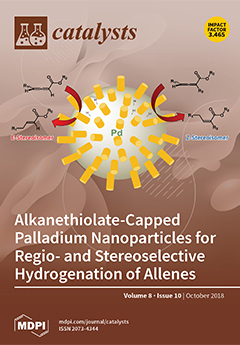Ceria supported metal catalysts often exhibit high activity in the preferential oxidation (PROX) of CO in H
2-rich stream and doping the ceria support with other metals proves to be rather effective in further enhancing their catalytic performance. Therefore, in this work,
[...] Read more.
Ceria supported metal catalysts often exhibit high activity in the preferential oxidation (PROX) of CO in H
2-rich stream and doping the ceria support with other metals proves to be rather effective in further enhancing their catalytic performance. Therefore, in this work, a series of ceria materials doped with Mn, Fe and Ni (CeM, where M = Mn, Fe and Ni; M/Ce = 1/8) were synthesized by a modified hydrothermal method; with the doped ceria materials (CeM) as the support, various supported gold catalysts (Au/CeM) were prepared by the colloidal deposition method. The influence of metal dopant on the performance of these ceria materials supported with gold catalysts in CO PROX was then investigated in detail with the help of various characterization measures such as N
2 sorption, XRD, TEM, Raman spectroscopy, H
2-TPR, XPS and XAS. The results indicate that the incorporation of Mn, Fe and Ni metal ions into ceria can remarkably increase the amount of oxygen vacancies in the doped ceria support, which is beneficial for enhancing the reducibility of ceria, the metal-support interaction and the dispersion of gold species. Although the gold catalysts supported on various doped ceria are similar in the size and state of Au nanoparticles, the CO conversions for CO PROX over Au/CeMn, Au/CeFe and Au/CeNi catalysts are 65.6%, 93.0% and 48.2%, respectively, much higher than the value of 33.6% over the undoped Au/CeO
2 catalyst at ambient temperature. For CO PROX over the Au/CeNi catalyst, the conversion of CO remains near 100% at 60–130 °C, with a PROX selectivity to CO
2 of higher than 50%. The excellent performance of Au/CeNi catalyst can be ascribed to its large amount of oxygen vacancies and high reducibility on account of Ni incorporation. The insight shown in this work helps to clarify the doping effect of other metals on the physicochemical properties of ceria, which is then beneficial to building a structure-performance relation for ceria supported gold catalyst as well as developing a better catalyst for removing trace CO in the hydrogen stream and producing high purity hydrogen.
Full article





